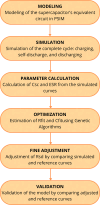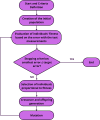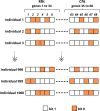Genetic algorithm for parameter optimization of supercapacitor model
- PMID: 40674340
- PMCID: PMC12270144
- DOI: 10.1371/journal.pone.0325645
Genetic algorithm for parameter optimization of supercapacitor model
Abstract
Electric energy storage systems have advanced significantly in recent years, driven by the growing expansion of renewable energy sources, the rise of electromobility, and other emerging configurations within the current electrical energy system. Among the various energy storage technologies, supercapacitors have gained considerable attention. Due to their ability to deliver large amounts of power over short periods, supercapacitors can be highly effective in hybrid storage systems, for example, enhancing overall system performance. Therefore, detailed studies on supercapacitors and their electrical circuit models have been developed with the aim of representing them as close as possible to actual physical behavior for numerous applications, such as in the context of Digital Twin (DT), an application that will support the monitoring of the operation and health of the supercapacitor throughout its useful life. The present work aims to estimate optimally some parameters of an electrical circuit model of a supercapacitor, in such a way as to obtain responses with very low errors and, thus, be able to use this computational electrical modeling for the development of a Digital Twin system. For the optimal adjustment of the electrical circuit model parameters, a Genetic Algorithm (GA) is used. The response of the electrical circuit, adjusted by the Genetic Algorithm (GA), is then compared to the response obtained through computer simulation of a supercapacitor using PSIM software, which is a software well validated in such studies. The results demonstrated strong alignment between the response using GA and the response using PSIM. Specifically, the charge and discharge curves of the supercapacitor, obtained through GA adjustment and PSIM simulation, were very similar, showing an error of just 2.2%. Thus, the supercapacitor model adjusted via GA demonstrates a good response to the physical phenomenon in question and can be used to develop a Digital Twin (DT) system, aiding in the operational and health monitoring of the supercapacitor.
Copyright: © 2025 Menezes et al. This is an open access article distributed under the terms of the Creative Commons Attribution License, which permits unrestricted use, distribution, and reproduction in any medium, provided the original author and source are credited.
Conflict of interest statement
The authors have declared that no competing interests exist.
Figures














References
-
- Poonam, Pareek K, Jangid DK. Analysis of the effect of different factors on the degradation of supercapacitors. Ionics. 2022;28(10):4527–45. doi: 10.1007/s11581-022-04650-z - DOI
-
- Zhang L, Hu X, Wang Z, Sun F, Dorrell DG. A review of supercapacitor modeling, estimation, and applications: A control/management perspective. Renewable and Sustainable Energy Reviews. 2018;81:1868–78. doi: 10.1016/j.rser.2017.05.283 - DOI
-
- Ratha S, Samantara AK. Supercapacitor: instrumentation, measurement and performance evaluation techniques. Springer; 2018.
-
- Ayob A, Ansari S, Lipu MSH, Hussain A, Saad MHM. SOC, SOH and RUL Estimation for Supercapacitor Management System: Methods, Implementation Factors, Limitations and Future Research Improvements. Batteries. 2022;8(10):189. doi: 10.3390/batteries8100189 - DOI
-
- Naseri F, Karimi S, Farjah E, Schaltz E. Supercapacitor management system: A comprehensive review of modeling, estimation, balancing, and protection techniques. Renewable and Sustainable Energy Reviews. 2022;155:111913. doi: 10.1016/j.rser.2021.111913 - DOI
MeSH terms
LinkOut - more resources
Full Text Sources

